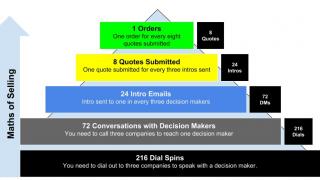
It can be easy to become overwhelmed by your sales targets - an affliction which strikes everyone within the sales arena from time to time. This tends to occur either when targets have been raised, or within months when things aren’t going to plan. Luckily, the maths of selling can be used to see the bigger picture and identify the smaller steps needed to achieve your sales goals.
The Maths of Selling - An Overview:
No matter what industry you’re in, or how high your sales target is, the maths of selling is an essential tool to help you meet your sales quota panic-free. It is the best way for an individual to plan to hit their target without simply concentrating on the revenue. After all, the reality is that a target is much more than just a figure - it’s a journey. The maths of selling simply allows you to check that you’re on the right path.
Think of the maths of selling as a funnel:
- If you pour in enough sales calls, you’ll reach enough decision makers.
- If you reach enough decision makers, you’ll be given permission to send enough introductory emails.
- If you’re given permission to send enough introductory emails, you’ll be presented with enough opportunities to quote.
- If you’re presented with enough opportunities to quote, you’ll win enough orders.
- If you win enough orders, then you’ll hit your target.
The trick is identifying how many calls you need to pour into that funnel for the rest of the sequence to play out. In short, you need to understand your key performance indicators thoroughly, as these form the individual objectives that need to be met.
Key Performance Indicators - What Are They?
Key performance indicators (KPIs) are the metrics that make up an overall target. For instance, in larger, sales-based organisations, staff are reprimanded for not hitting KPIs such as daily call volumes. Although the salesperson’s overall target is based on revenue and not call volumes, the organisation understands that if this KPI is missed consistently, then the individual’s chances of achieving their revenue target are substantially lowered. This is the maths of selling coming into play.
To understand your own maths of selling, you first need to identify the following key performance indicators:
- How many orders you need to hit your target.
- How many jobs you need to quote to win one order.
- How many introductory emails you need to send/how many sales meetings you need to attend for one quoting opportunity.
- How many decision makers you need to speak to to be invited to send one introductory email or attend one sales meeting.
- How many telephone calls you need to make to speak to one decision maker.
You may need to monitor these figures over a period of roughly three months to build up an accurate picture, but once you have your own personal data to input into the formula, you’ll find that your sales target becomes less about a (somewhat daunting) revenue figure and more about the everyday tasks you need to accomplish to get there.
When working out your formula, it’s important to bear in mind that you need to work backwards. The first step is to uncover the amount of orders you need and work from there. Using Qimtek’s own data, we recently revealed that our members need to quote an average of 8.8 jobs to win one new customer. This serves as an estimate but it’s also important to bear in mind that ‘organic’ sales methods tap into a much more volatile market than that of the Qimtek membership - after all, the Qimtek membership focuses on buyers with an active requirement who have invited our members to quote, whereas the general market reflects much more of a cross-section of interest/business needs.
What Are the Benefits of Using the Maths of Selling?
It’s no secret that sales can sometimes be a stressful profession, especially if you’re fitting it around the other day-to-day tasks associated with running an engineering company. By segmenting your target into bitesize chunks, you can be sure to eliminate some of the associated stress - after all, it feels much more achievable to quote for four jobs per week than it does to bring in £10,000 worth of new business!
Because the maths of selling is both universal and adaptable, you can also use it to keep on track at events such as exhibitions. Using scaled-down metrics, you can ensure that you speak to the right amount of decision makers to result in the orders you need to call the show a success. In fact, the maths of selling is a completely flexible model that can be customised to monitor progress with every type of sale, from account management through to new business.
By breaking down your sales process accordingly, you will be armed with a clear, organised game plan. Therefore, the maths of selling makes your targets much more attainable versus adopting a scattergun approach and hoping for the best.
The Maths of Selling and the Manufacturing Market:
It’s a well-known fact that manufacturing and engineering companies devote less time and budget to marketing in comparison to other industries. According to Carl Jarvis’ book ‘Marketing For Manufacturers’, this figure is even more shocking than it may appear to be on the face of things. In fact, he informs us that many such companies allocate only 0.5% of their budget towards their marketing efforts, whereas a healthy marketing investment sits around the 5-10% mark.
Therefore, the manufacturing industry needs to work harder to compensate for the general lack of marketing investment. This prerequisite dictates that the figures input into the maths of selling formula may be slightly less forgiving than those for other industries - for instance, you may find that you need to make more sales calls in order to speak to a decision maker, or quote more jobs in order to win an order - but rest assured that the model will still work provided that you’re realistic about your KPIs. If you underestimate these, then you may find yourself burdened with a sales deficit at the end of the month which could have easily been avoided by double-checking the applicable foundations. This is why it’s so important to carry out KPI research over an extended period of at least three months.
Maths of Selling - A Final Point:
Although the maths of selling will provide you with guidelines surrounding required input to achieve desired output, it’s worth bearing in mind that there are many variables that can throw your formula out of kilter. For instance, the overall health of the market will inevitably affect the amount of jobs available to quote, meaning that you may need to speak to more decision makers to uncover the required amount of opportunities.
If you find that a formula you have previously found to be accurate is now resulting in discrepancies, you may need to update your figures accordingly. The maths of selling is subject to change, meaning that monitoring progress against your KPIs is vital not only to your sales success, but also to the continued accuracy of the KPIs themselves.
By treating maths of selling as a fluid formula, you will, over time, be able to pre-empt your approach in line with industry trends, making sure you know how to respond to shifts in the market as soon as they occur.
--
If you would like to read the previous instalments in the sales series, these can be accessed here:
